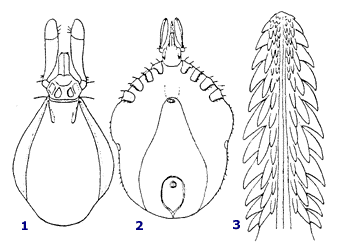IXODES HOLOCYCLUS Neumann (paralysis tick)
General anatomy: introduction, male, female, nymph, larva
Description of Roberts FHS (1960): A systematic study of the Australian species of the genus Ixodes (Acarina: Ixodidae). Australian Journal of Zoology 8:392-485.: contents, summary, the genus Ixodes, key to Australian Ixodes sp, male, female, nymph, larva, hosts and distribution, comments, differentiating I. cornuatus
Flurescence of Ixodes holocyclus
Introduction
Whilst pioneering settlers knew that ticks posed a threat to their dogs and perhaps to themselves, the paralysis tick was not scientifically identified until 1899 (by Neumann). It was further studied by Nuttal and Warburton (1911). The life cycle was studied chiefly by Ross (1924) and Oxer and Ricardo (1942) and later summarised by Seddon (1951).
Male
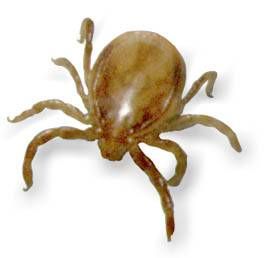
Body: oval, sometimes broadly so, 1.9 x 1.6 mm- 3.2 x 2.3 mm; marginal body fold narrow but prominent; hairs dorsally sparse medianly, more numerous on marginal body fold.
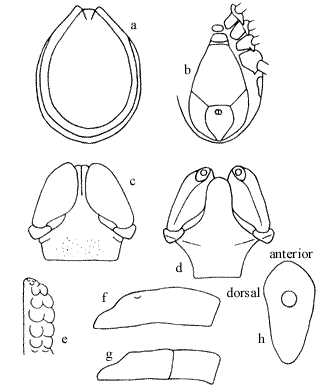
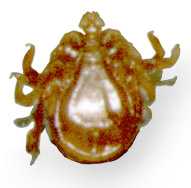
I. holocyclus male- a, body (dorsal view); b, body (ventral view); c, capitulum (dorsal view); d, capitulum (ventral view); e, hypostome; f, tarsus I; g, tarsus IV; h, spiracular plate
Capitulum: length 0.51- 0.65 mm in width, surface
punctate; posterior margin straight; no cornua; posterolateal
margins slightly divergent anteriorly; basis ventrally narrowing
to the straight posterior margin, surface with a short
anterolateral ridge. Palps short and broad; article 1 rounded and
a little salient laterally, ventrally with a transverse rounded
flange continous with ridge on basis; articles 2 and 3 with no
apparent suture, 0.33- 0.40 mm in length, almost twice as long as
broad, rounded distally, hairs moderate in number, some long
hairs ventrally. Hypostome short and borad, 0.25- 0.28 mm in
length, narrowing and shallowly rounded distally; dentition 2/2
of large rounded teeth, some small teeth distally and
crenulations basally.
Scutum: oval, convex, only a little smaller than body.
Lateral grooves deep and completely encircling the scutum,
anteriorly somewhat linear and may simulate mild lateral carinae.
Punctations fine, usually most numerous submarginally and
anteromedianly; pseudoscutum sometimes faintly apparent. Cervical
grooves, short, shallow. Emargination moderate. Scapulae blunt.
Genital aperture: on a level with anterior margin of coxa
III, sometimes at level of 2nd intercoxal space.
Ventral plates: pregenital plate wider than long; median
plate 1.5 x 1.2 mm, the width posteriorly about 3/4 of the
length; anal plate 0.75 x 0.50 mm, anterior margin straight or
mildly curved, pointed posteriorly; adanal plates curving to
points near the point of the anal plate; plates with scattered
punctuations and hairs.
Spiracular plate: elongate, oval, narrow posteriorly, the
longer axis directed anteriorly, about 0.50- 0.53 mm in length.
Legs: length moderate. Coxae practically continguous, with
a row of long hairs near posterior margin; posterointernal angles
of coxae I and II may be somewhat sharp but not salient; all
coxae with an external spur, strongest and bluntly pointed on
coxa I, smallest on coxa IV. Trochanters III and IV with a small,
dark ventral spur, only a tuberosity on II. Tarsi ending somewhat
abruptly; length of tarsus I 0.65- 0.71 mm, and of tarsus IV 0.62-
0.70 mm.
Female
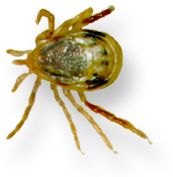
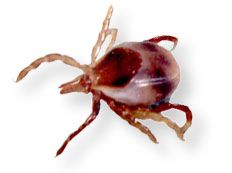
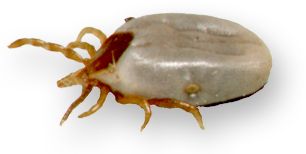
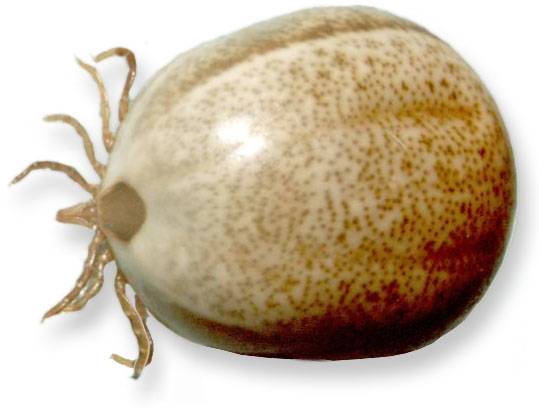
Body: unfed specimens, oval , flat, yellowish, 2.6 x 1.1 mm - 3.8 x 2.6 mm; marginal groove well developed and continuous; hairs small, scattered, most numerous in region of marginal fold. Semi-engorged specimens frequently with body widest behind coxa IV and with a waist at level of spiracles. Fully engorged specimens broadly oval, attaining 13.2 x 10.2 mm, living ticks with blue-grey alloscutum, the dorsum light in colour, a dark band in region of marginal groove.
|
Ixodes holocyclus,
female, partially engorged 1, capitulum and scutum, dorsal aspect 2, ventral aspect 3, hypostome (from Neumann, 1899) |
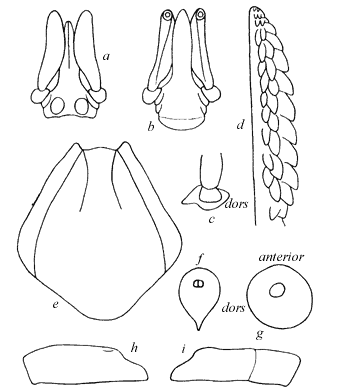

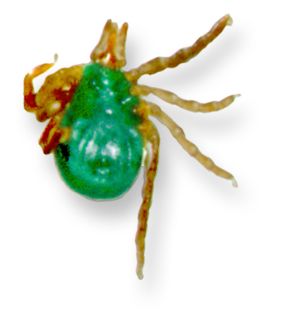
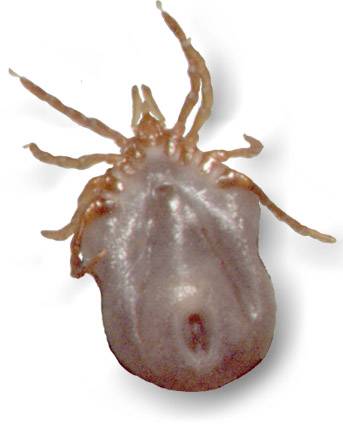
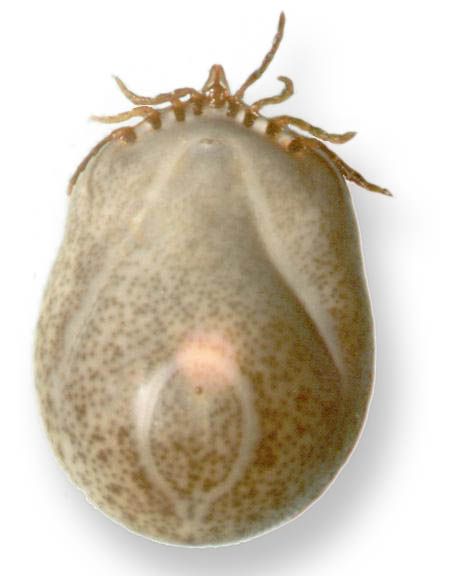
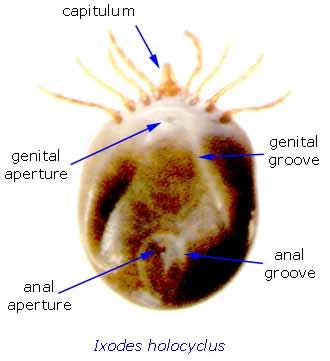
I. holocyclus: female; a, capitulum (dorsal view); b, capitulum (ventral view); c, palpal article I (lateral view); d, hypostome; e, scutum; f, anal grooves; g, spiracular plate; h, tarsus I; i, tarsus IV.
Capitulum: length 1.00- 1.035 mm. Basis dorsally 0.60-
0.68 mm in width, the lateral submarginal fields swollen and
frequently delimited from the depressed, median field by ill-defined
carinae; posterior margin sinous, posterolateral angles swollen,
sometimes mildly salient; porose areas large, deep subcircular or
oval, the longer axis directed anteriorly, interval frequently
depressed, at most about the width of one; basis ventrally with
posterior margin rounded and with well-defined, blunt, retrograde
auriculae. Palps long and slender, some long hairs ventrally;
article I rounded and somewhat salient laterally, inner "ring"
with dorsal tongue-like prolongation and ventrally semicircular
and plate-like, the posterior margin of the plate extending
beyond the palp; articles 2 and 3 with no apparent suture, 0.75-
0.85 mm in length and about four times as long as wide, narrowly
rounded distally. Hypostome lanceolate and bluntly pointed;
dentition mainly 3/3, the innermost file of small, spaced teeth,
basally 2/2.
Scutum: as wide as or a little wider than long, widest a
little posterior to mid length, 1.6 x 1.7 mm- 2.4 x 2.4 mm, flat
medianly, convex external to the long, strong lateral carinae;
anterolateral margins practically straight, posterolateral
margins mildly concave; posterior anle broadly rounded.
Punctations numerous , fine, sometimes a little coarser medianly
and laterally, shallow rugae frequently present posteriorly.
Cervical grooves well defined but short. Emargination moderate.
Scapulae blunt.
Genital aperture: on a level with coxa IV, but in engorged
specimens sometimes just posterior to this level.
Anal grooves: rounded anteriorly, curving behind anus to
meet in a somewhat elongate point.
Spiracular plate: subcircular, greatest dimension 0.40- 0.45
mm.
Legs: coxae smooth, I and II sometimes with mild rounded
ridges externally, each with a row of long hairs posteriorly and
an external spur, longer and more pointed than in male, and
decresing in size posteriorly. Trochanter IV (and sometimes III)
frequently with a small, ventral spur. Tarsi tapering a little
abruptly; length of tarsus I 0.70- 0.80 mm, and of tarsus IV 0.60-
0.78 mm. (Roberts,
1969 & 1970)
Nymph
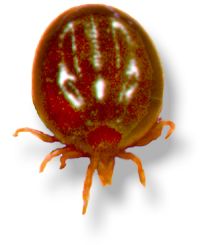
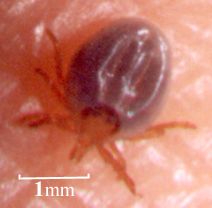
Body: unfed specimens oval with fine parallel striae
and some small scattered hairs; 1.20 x 0.85 mm; marginal groove
well defined; engorged specimens to 3.5 x 2.5 mm.
Capitulum:
length 0.40- 0.43 mm. Basis dorsally 0.23- 0.25 mm in width;
posterior margin straight; posterolateral angles not salient;
auriculae well defined. Palps as in female; articles 2 nd 3 0.30-
0.32 mm in length. Hypostome lanceolate and bluntly pointed;
dentition 2/2, 3/3 distally.
Scutum: about as wide as long, 0.61 x 0.63 mm - 0.71 x 0.70
mm. Lateral carinae well developed . Punctations few, shallow,
scattered. Cervical grooves apparent, continuing to mid-scutal
region as superficial depressions.
Sternal plate: oval, 0.27- 0.30 mm in length and a little
more than twice as long as wide.
Spiracular plate: subcircular, greatest diameter about 0.14
mm. Legs: coxae armed as in female. Tarsus I tapering
gradually, other tarsi more abruptly; length of tarsi I and IV
about 0.28 mm. (Roberts,
1969 & 1970)
Larva
Roberts FHS (1960): A systematic study of the Australian species of the genus Ixodes (Acarina: Ixodidae). Australian Journal of Zoology 8:392-485:
AUSTRALIAN SPECIES OF THE GENUS IXODES (ACARINA: IXODIDAE)
By F. H. S. ROBERTS
Division of Animal Health, C.S.I.R.O., Veterinary Parasitology Laboratory, Yeerongpilly, Qld.
[Manuscript received June 10, 1960]
CONTENTS
Summary
Introduction
Genus Ixodes Latreille
Keys to Australian species
Description of species
Host-parasite list
Acknowledgment
References
List of species
SUMMARY
A systematic study has been made of the species of Ixodes (Ixodidae) occurring in Australia.
Nineteen species wore recognized in the material available for examination, namely I. uriae, I. kohlsi, I. eudyptidis, I. pterodromae, I. simplex simplex. I. vespertilionis, I. ornithorhynchi, I. tasmani, I. hydromyidis, I. australiensis, I. victoriensis, I. fecialis, I. antechini, I. vestitus, I. holocyclus, I. confusus, I. cornuatus, I. hirsti, and I. trichosuri. Four of these, I. antechini, I. cornuatus, I. confusus, and I. trichosuri, are regarded as new species and I. simplex simplex and I. pterodromae are recorded from Australia for the first time. I. rothschildi recorded by, Arthur (1953) from Western Australia was not encountered.
A detailed description with appropriate figures is given for each species, including all known stages in the life cycle, together with data on host range and geographical distribution. Keys are supplied for the known males, females, nymphs, and larvae and a classified host list has been compiled.
INTRODUCTION
The revision of the world species of Ixodes by Neumann (1899) included three species from Australia, namely I. ornithorhynchi Lucas, I. tasmani and I. holocyclus, the last two being described for the first time. Two further new species were added by this worker, I. australiensis in 1904 and I. vestitus in 1908, and Warburton and Nuttall described I. fecialis and its variety I. fecialis aegrifossus in 1909. Two years later Nuttall and Warburton (1911) contributed their section on the genus Ixodes in their classical monograph "Ticks, a Monograph of the Ixodoidea" in which they recognized all the above species and also I. vespertilionis Koeh. They also referred to I. uriae White (I. putus Pickard-Cambridge) recorded by Neumann (1911) from King L, Tas., which Neumann considered as being in British Columbia, but was noted by Nuttall and his colleague as "?Tasmania."
Further records by Nuttall (1916) referred to the synonymy of I. fecialis aegrifossus with I. fecialis, to the occurrence of I. percavatus Neumann and I. eudyptidis Maskell on sea birds, and to a new species, I. victoriensis, from the wombat.
Three more species have since been described, namely, I. hirsti Hassall, 1931 (I. victoriensis Hirst, 1930), I. hydromyidis Swan, 1931, and I. kohlsi Arthur, 1955, and Arthur (1953) recorded the presence of I. rothschildi Nuttall & Warburton, 191I.
Schulze (1935) in an account of species from Australia and New Guinea concluded that the tick identified by Ross (1924) as I. holocyclus, and on which Ross based his excellent observations on the biology of this species and of the paralysis it causes in the dog, was not I. holocyclus of Neumann (1899) and referred Ross' specimens to a new species I. rossianus. Schulze also considered that two subspecies of I. tasmani were present which he called I. tasmani tasmani and I. tasmani victoriae.
Accounts of the Australian species have also been contributed by Rainbow (1906), Ferguson (1925), Fielding (1926), and by Taylor and Murray (1946). These were based mainly on the literature, but added several new host and locality records.
When these studies were commenced then the following species had been recorded from Australia: I. tasmani (subspecies I. tasmani tasmani and I. tasmani victoriae), I. ornithorhynchi, I. holocyclus, I. rossianus, I. hirsti, I. vestitus, I. fecialis, I. australiensis, I. hydromyidis, I. victoriensis, I. kohlsi, I. rothschildi, I. percavatus, I. uriae, I. eudyptidis, and I. vespertilionis.
The material studied by the author did not include I. rothschildi. Four new species were present which have been called I. antechini, I. confusus, I. cornuatus, and I. trichosuri, and two species not hitherto recorded from Australia, namely I. simplex simplex Neumann, and I. pterodromae, were identified. The most abundant species was I. holocyclus (see p. 459 for synonymy of I. rossianus with this species) which is not surprising as it has a wide distribution and is notorious as a cause of serious paralysis in domestic animals and man. I. tasmani was also well presented as were also I. hirsti, I. trichosuri, I. fecialis, I. ornithorhynchi, and I. kohlsi. Only a small number of specimens of I. australiensis, I. victoriensis, I. vestitus, I. hydromyidis, I. pterodromae, I. simplex simplex, and I. eudyptidis was seen. Australian specimens of I. uriae were also few, but a good series from Heard and Macquarie Is. was available. Males of only I. holocyclus were seen in good numbers and this sex in I. ornithorhynchi, I. victoriensis, I. australiensis, I. hydromyidis, I. vestitus, I. pterodromae, and I. simplex simplex remains undescribed. The nymphs and larvae of several species were recognized but here again these stages in other species remain unknown.
The biology of I. holocyclus has been studied extensively, and an excellent summary of these studies is given by Seddon (1951). Other than the species recorded from sea birds, the Australian species appear to have been collected mainly from animals. The avian host records include I. holocyclus, female, nymph, and larva, from the domestic fowl and duck, the female from the crow, Corvus coronoides, and the nymph from the dragoon bird, Pitta sp., nymphs of an undetermined species (I. hirsti?) from the pilot bird, Pycnoptilus floccosus, and an undetermined larva (I. hirsti?) from the scrub-wren Sericornis frontalis. The only species recorded from man are I. holocyclus (male (crawling), female, nymph, larva), I. cornuatus (female), I. kohlsi (nymph), I. tasmani (female), and L-confusus (female). Species attacking domestic animals include I. holocyclus (all domestic animals), I. tasmani (horse, dog, cat), I. hirsti (cat), I. cornuatus (dog, cat), and I. australiensis (dog, cow). Only two species have been recorded from Reptilia, namely, I. vestitus from the brown snake, Demansia textilis, and I. ornithorhynchi from the blue-tongued lizard.
The genus Ixodes includes several species in various parts of the world which are vectors of important diseases of man and domestic animals, but in Australia only I. holocyclus has been implicated in this regard. This species is an experimental vector of Q-fever (Coxiella burneti (Derrick)), which it can transmit from stage to stage. It is best known, however, by its ability to cause a serious and frequently fatal condition of paralysis in man and the domestic animals (Seddon 1951).
The morphological terms used throughout are in conformity with the definitions set down by Nuttall and Warburton (1911) and by Cooley and Kohls (1945). The lateral grooves in the male are seen in only a few species, running inside the edge of the scutum and giving the species double dorsal folds (e.g. I. holocyclus). In some species, these grooves are represented anteriorly by carinae, usually mild (e.g. I. hirsti). The anteroposterior ridges which are apparent on the dorsal, and sometimes also on the ventral surfaces of the basis capituli, are also referred to as carinae. All measurements are given in millimetres. Body length has been taken from the tip of the scapulae to the caudal margin, and the width of the basis capituli as the maximum width, but not including palpal article I. Dimensions of the scutum include the length from the tip of the scapulae to the level of the margin of the posterior angle, and the width as the greatest width across the scutum.
Drawings were made with a compound microscope aided by a camera lucida. Whenever possible whole ticks preserved in alcohol were used, care being taken not to allow the specimens to dry out. Drawings of the hypostomes and of some of the larvae relied on mounts.
The material examined came from the collections of the Animal Research Institute, Department of Agriculture and Stock, Queensland; the Queensland Institute of Medical Research; the Queensland Museum; the Department of Entomology, University of Queensland; the Australian Museum; the School of Public Health and Tropical Medicine, University of Sydney; the McMaster Laboratory, C.S.I.R.O. (Mr. M. D. Murray); Wildlife Survey Section, C.S.I.R.O., Canberra; the National Museum of Victoria; the Victorian Department of Agriculture; the South Australian Museum; the Western Australian Museum; the Western Australian Department of Agriculture; and the Tasmanian Museum.
GENUS IXODES Latreille
Type species Ixodes ricinus (Linnaeus) Latreille, 1804.
Definition.-Inornate and without eyes or festoons; anal grooves surrounding anus anteriorly and usually uniting in a point or arch; tarsi rarely with spurs; spiracular plate round or oval; male scutum surrounded by a usually prominent body fold and male venter with 7 well-defined, non-salient chitinous plates, namely 1 pregenital, 1 median, 1 anal, 2 adanal, and 2 epimeral; sexual dimorphism frequently marked, especially in the palpi and hypostome.
The synonymy of Ixodes is given by Nuttall and Warburton (1911), by Cooley and Kohls (1945), and by Kohls (1957a) and includes Ceratixodes and Eschatocephalus. Ceratixodes was created by Neumann (1902) for I. uriae ( = I. putus Pickard-Cambridge), but was later degraded by him (1904) to a subgenus. Eschatocephalus Frauenfeld, 1853, was retained by Neumann (1902) for I. vespertilionis L. Koch, but was also subsequently relegated to a subgenus (Neumann 1904). Ceratixodes has since been recognized as a genus by a number of workers including Schulze (1941), Zumpt (1952), and Arthur (1956b). Pomerantzev (1950) regarded it as a subgenus but Kohls (1957a) listed it simply as a synonym of Ixodes. Eschatocephalus was given subgeneric rank by Pomerantzev (1950) and Arthur (1956b), while Schulze (1935) considered it worthy of generic status.
Schulze (1935) created additional subgenera including Sternalixodes, Endopalpiger, Exopalpiger, and Lepidixodes. [Lepidixodes was created for I. kopsteini Koeh. Anastos (1950) considered this species to be a special kind of mite and saw no reason for regarding it as a tick, let alone a species of Ixodes.] Later, this worker (1941) divided the Prostriata into two groups, mainly on the structure of Haller's organ, and these he called the Thecorina, or capsule-nosed ticks, and the Phynorhina or trough-nosed ticks. Schulze further contended that trough-nosed species hitherto in the genus Ixodes must be renamed and proceeded to define the genera Coxixodes, which was based on I. ornithorhynchi, Scaphixodes, and Xiphixodes. Arthur (1956b), who studied the details of Haller's organ in many species of Ixodes, considered firstly that while such a broad classification into the Thecorina and Phynorhina was valid for British ticks it was not universal, and secondly that any attempt to apply Schulze's classification to all ticks with trough-nosed capsules would result in a number of genera each with a single species. Kohls (1957a) also considered there was little reason for recognizing Coxixodes, Scaphixodes, and Xiphixodes and remarked "The type and only contained species of each of these exhibit unusual morphological patterns, but I do not regard these species as sufficiently distinct to require the splitting up of the old and well-established parent genus".
The Australian species fall into well-defined groups which come within the definitions of Sternalixodes, Endopalpiger, Exopalpiger, and Ixodes s.s. I. holocyclus, I. cornuatus, I. confusus, I. hirsti, and I. trichosuri belong to Sternalixodes. These have a sternal plate in the female or nymph [Schulze (1935) reported a sternal plate also in the nymph of I. prissicollaris, the type of his subgenus Exopalpiger.]. The females possess a large scutum, which in unfed specimens covers a large area of the dorsum, strong scutal carinae, an elongate lanceolate hypostome, long slender palpi, armed coxae, and anal grooves which are closed behind. The males are all very similar morphologically with lateral grooves, and an anal plate bluntly pointed posteriorly.
I. victoriensis, I. australiensis, I. tasmani, and I. hydromyidis all belong to Endopalpiger, and are characterized by the greatly enlarged article 1 of the palpi, which extends inwardly and anteriorly to ensheathe the basal area of the mouthparts, and is salient laterally, particularly ventrally. All have relatively broad scuta and scutal lateral carinae are absent.
Exopalpiger includes I. fecialis, I. vestitus, and I. antechini with palpal article 1 enlarged and inserted diagonally on the basis, capituli with which it is fused. This article is strongly salient laterally but extends at most only a short distance inwardly. The basis is furnished with carinae as is also the scutum. The coxae are unarmed except in I. antechini and possess posterior membranous outgrowths (syncoxae).
The remaining species belong to the subgenus Ixodes s.s.
KEY TO THE AUSTRALIAN SPECIES OF THE GENUS IXODES
Males (the males of victoriensis,
australiensis, hydromyidis, vestitus, ornithorhynchi, eudyptidis,
pterodromae, and simplex simplex have not been described)
Females
Nymphs (the nymphs of confusus,
cornuatus, hirsti, and victoriensis have not been
described)
Larvae (the larvae of confusus, cornuatus,
hirsti, antechini, fecialis, australiensis, pterodromae and
victoriensis have not been described)
Males
1. Body with 5 posterior brushes of hairs (sea bird habitats) > I. uriae
Body without such brushes of hairs > 2
2(1). Legs inordinately long, much longer than body (bat habitats) > I. vespertilionis
Legs not as above > 3
3(2). Lateral grooves distinct but not necessarily complete > 4
Lateral grooves absent > 8
4(3). Scutum with lateral carinae > 5
Scutum without lateral carinae > 6
5(4). Trochanters with spurs > I. confusus
Trochanters devoid of spurs > I. hirsti
6(4). Lateral grooves completely encircling scutum, or almost so > 7
Lateral grooves apparent posteriorly only > I. trichosuri
7(6). Body measurements at least 3.0 by 2.5 mm > I. cornuatus
Body measurements less than 3. 0 by 2. 5 mm > I. holocyclus
8(3). Article 1 of palpi greatly enlarged, extending inwardly and anteriorly to ensheathe base
of mouthparts > I. tasmanii
Article 1 of palpi not as above > 9
9(8). Anal plate constricted medianly; hypostome bilobed distally, dentition greatly reduced
(sea bird habitats) > I. kohlsi
Anal plate not, constricted medianly; hypostome and dentition not as above > 10
10(9). Small, narrowly oval ticks, hypostome dentition 2/2 > 11
A medium-sized, broadly oval tick; hypostome dentition mainly 4/4 and 3/3 (sea bird
habitats) > I. rothschildi
11 (1 0).Coxa I with a small external spur > I. antechini
Coxa without such a spur > I. fecialis
Females
1. Legs inordinately long, giving a spidery effect > I. vespertilionis
Legs not as above > 2
2(1). Anal grooves meeting posteriorly > 3
Anal grooves widely separated posteriorly > 8
3(2). Palpal article 1 greatly enlarged, ensheathing base of mouthparts, capitulum short > I. australiensis
Palpal article 1 not as above; capitulum long > 4
4(3). Sternal plate present > 5
Sternal plate absent > 7
5(4). Coxae with > 6
Coxae smooth > I. trichosuri
6(5). Basis capituli with 3 carinae dorsally and ventrally; trochanters with spurs > I. confusus
Basis capituli with only 2 carinae dorsally and ventrally; trochanters without spun > I. hirsti
7(4). Basis capituli with well-defined bluntly pointed cornua > I. cornuatus
Basis capituli with at most only shallow rounded cornua > I. holocyclus
8(2). Hypostome dentition 2/2 > 9
Hypostome dentition more than 2/2, particularly in distal area > 12
9(8). Scutum widest anteriorly, palpal article 3 broader than palpal article 2 (sea birds) > I. uriae
Scutum widest towards or posterior to mid-length, palpal article 3 not broader than palpal
article 2 > 10
10(9). Scutum wider than long and widest towards mid-length > I. vestitus
Scutum longer than wide and widest posteriorly > 11
11(10).PaIpal article 1 triangular, scutum only a little longer than wide; coxa I unarmed > I. fecialis
Palpal article I somewhat rectangular, scutum almost twice as long as wide, coxa I with
small, but distinct, external spur > I. antechini
12(8). Palpal article 1 greatly enlarged and ensheathing base of mouthparts > 13
Palpal article 1 not as above > 15
13(12).Basis capituli with cornua; coxae with spurs > I. victoriensis
Basis capituli without cornua; coxae without spurs > 14
14(13).Scutum a little longer than wide, punctations fine; porose areas superficial > I. hydromyidis
Scutum wider than long, punctations numerous and relatively coarse; porose areas
well defined > I. tasmani
15(12).Coxae with spurs (sea birds) > 17
Coxae without spurs > 16
16(15).Scutum longer than wide; hypostome dentition with 4 rows of 3/3 (bats > I. simplex simplex
Scutum wider than long; hypostome dentition with about 7-8 rows of 3/3 > I. ornithorhynchi
17(15).Article 1 of palpi with a strong, internal, anteriorly directed horn-like protrusion and a
distinct mesodorsal spur (sea birds) > I. pterodromae
Article 1 of palpi not as above > 18
18(17).Basis capituli with cornua > 19
Basis capituli without cornua > I. eudyptidis
19(18).Anal grooves markedly constricted posteriorly (sea birds) > I. kohlsi
Anal grooves at most only slightly constricted posteriorly (sea birds) > I. rothschildi
Nymphs
1. Legs inordmately long, giving a spidery effect (bate) I. vespertilionis
Legs not as above > 2
2(1). Sternal plate present > 3
Sternal plate absent > 4
3(2). Anal grooves narrowly open posteriorly; hypostome bluntly pointed, dentition 3/3 and 2/2 > I. holocyclus
Anal grooves closed posteriorly; hypostome acutely pointed, dentition 2/2 > I. trichosuri
4(2). Scutum with lateral carinae > 5
Scutum without lateral carinae > 8
5(4). All coxae with spurs. (sea birds > I. rothschildi
At most only 1 coxa with spur > 6
6(5). Scutum much longer than wide; coxa with a small but distinct external spur > I. antechini
Scutum at most little longer than wide; coxa I unarmed > 7
7(6). Article 1 of palpi triangular > I. fecialis
Article 1 of palpi somewhat discoidal > I. vestitus
8(4). Palpal article 1 greatly enlarged and ensheathing base of mouthparts > 9
Palpal article 1 not as above > 11
9(8). Coxae armed > I. australiensis
Coxae unarmed > 10
10(9). Scutum with few and fine punctations; cervical grooves not attaining posterior margin
of scutum I. hydromyidis
Scutum with numerous, relatively coarse punctations; cervical grooves running full
length of scutum I. tasmnanii
11(8). Palpal article 1 extending inwardly and anteriorly as a well-developed spur (sea birds) >
I. pterodromae
Palpal article 1 without such a spur > 12
12(1 1).Coxae armed > 13
Coxae unarmed > 14
13(12).Basis capituli with cornua (sea birds) > I. kohlsi
Basis capituli without cornua (sea birds) I. eudyptidis
14(12).Hypostome dentition with rows at most 2/2 > 15
Hypostome dentition with rows of 3/3 (bats) I. simplex simplex
15(14).Palpal article 3 wider than palpal article 2; scutum with greatest width anteriorly (sea,
birds > I. uriae
Palpal article 3 not wider than palpal article 2; scutum with greatest width near mid-
length I. ornithorhynchi
Larvae
1. Coxae with spurs > 8
Coxae without spurs > 2
2(1). On bats > 3
On other hosts > 4
3(2). Tarsi 0. 13 mm in length > I. simplex simplex
Tarsi 0. 34-0.44 nun in length > I. vespertiolionis
4(2). Palpal article 1 enlarged and extending inwardly to base of mouthparts > 5
Palpal article 1 not as above > 6
5(4). Cervical grooves well defined, attaining posterior margin of scutum I. tasmani
Cervical grooves faint and not attaining posterior margin of scutum I. hydromyidis
6(4). Scutum longer than wide and widest anterior mid-length, (sea birds) > I. uriae
Scutum wider than long and widest near or posterior to mid-length > 7
7(6). Scutum with lateral carinae > I. vestitus
Scutum without lateral carinae > I. ornithorhynchi
8(1). Scutum widest well anterior to mid-length (sea birds) > 9
Scutum widest near mid-length > 11
9(8). Basis capituli with cornua > I. kohlsi
Basis capituli without cornua > 10
10(9). Scutum wider than long > I. eudyptidis
Scutum longer than wide > I. rothschildi
11(8). Coxe, III with a small spur > I. holocyclus
Coxa III unarmed > I. trichosuri
IXODES HOLOCYCLUS Neumann
Ixodes holocyclus Neumann, 1899, pp. 151-5, figs. 24-6; 1901, p. 249. Rainbow, 1906, p. 167. Nuttall and Warburton, 1911, pp. 235---8,figs. 230-2. Ross, 1924, pp. 365- 81, figs. 1 and 2, pl. 15, figs. 1-18. Ferguson, 1925, pp. 27-8. Fielding, 1926, pp. 39, 40, fig. 10. Sharif, 1928, pp. 230, 232-3. Krijgsman and Ponto, 1932, pp. 27-8, figs. 43-4. Taylor and Murray, 1946, pp. 48-52, figs. 51-3. Seddon, 1951, pp. 119-33, with figure showing distribution. Roberts, 1959, p. 268 (see also Roberts, 1954, p. 144).
Not Ixodes holocyclus. Schulze, 1935, pp. 34-6, fig. 5. Ixodes (Sternalixodes) rossianus Schulze, 1935, p. 36. Sternalixodes rossianus Arthur, 1956b, p. 272.
Male
Diagnosis
Body measurements less than 3.0 by 2.5 mm; lateral grooves completely encircling scutum, no lateral carinae; punctations fine; basis capituli punctate dorsally, palpi short and very broad; hypostome dentition 2/2, with rounded teeth; anal plate bluntly pointed behind; adanal plate curving inwardly to a point; coxae with well-defined external spurs decreasing in size posteriorly; trochanters III and IV frequently with small, ventral spurs.
Description

I. holocyclus male- a, body (dorsal view); b, body (ventral view); c, capitulum (dorsal view); d, capitulum (ventral view); e, hypostome; f, tarsus I; g, tarsus IV; h, spiracular plate
Body-Oval, widest at about mid-length, and broadly rounded posteriorly, 1.9-2.8 mm by 1.6-2.1 mm; marginal body fold narrow; hairs few and scattered, most numerous in region of marginal body fold.
Capitulum-Short, 0.51-0.60 mm in length; basis dorsally 0.4mm wide, surface punctate, posterior margin straight, posterolateral margins straight, slightly divergent anteriorly, no cornua; palpi short and very broad, article 1 wider than long, rounded, and a little salient laterally, ventrally with an erect semicircular flange, which is continuous with a short ridge on basis, articles 2 and 3 apparently fused, 0.33 mm in length, widest medianly and about twice as long as wide.
Hypostome short and broad, rounded apically, about 0.25 mm in length; dentition 2/2 of about 5 rounded teeth, decreasing in size basally, where the teeth appear ag fine crenulations, a few small denticles apically.
Scutum.-Convex, glossy, measurements only a little less than those of body; lateral grooves deep and completely encircling the scutum; punctations fine, scattered, usually most numerous anteriorly and laterally, pseudoscutum sometimes faintly visible; no lateral carinae; cervical grooves short, shallow, convergent; emargination moderate; scapulae bluntly pointed.
Genital aperture-At level of anterior margin of coxa III, sometimes in second intercoxal space.
Ventral plates.-Pregenital plate hexagonal and wider than long; median plate very broad posteriorly where the width is about three-quarters the length; anal plate with anterior margin straight or slightly convex, the sides curved, bluntly pointed behind; adanal plates curving posteriorly to points which meet or almost meet behind the point of the anal plate; plates almost impunctate, with some short, pale hairs.
Spiracular plate.-Elongate oval, the longer axis directed anteriorly, about 0 - 5 mm in length and about twice as long as wide.
Legs-Of moderate length; coxae contiguous, flat, the posterointernal angles, especially of coxae I-III, somewhat sharp, with well-developed, external, blunt spurs decreasing in size posteriorly, and a row of long, pale hairs near the posterior margin; trochanters III and IV frequently with small, pointed, ventral spurs, at most tuberosities on trochanters I and II; tarsi tapering gradually, particularly tarsus I, tarsus I 0.65-0.67 mm in length, tarsus IV 0.62-0.64 mm in length.
Female
Diagnosis
A very large tick when fully engorged; scutum about as long as broad and broadest a little posterior to mid-length, with strong, lateral carinae; capitulum relatively long, porose areas deep, cornua usually absent, but when present at most only mild and rounded; auriculae present; hypostome lanceolate, dentition mainly 3/3; no sternal plate; anal grooves meeting at a point behind; all coxae with an external spur decreasing in size posteriorly; trochanters III and IV usually with small, pointed ventral spurs.
Description

I. holocyclus: female; a, capitulum (dorsal view); b, capitulum (ventral view); c, palpal article I (lateral view); d, hypostome; e, scutum; f, anal grooves; g, spiracular plate; h, tarsus I; i, tarsus IV.
Body.-Unfed specimens with flat, oval body, widest posteriorly, 2-6-3.8 mm by 1.1-2.6 mm; marginal grooves well developed, complete; some pale, scattered hairs most numerous in region of marginal fold; body in semi-engorged specimens frequently widest just behind coxa IV and with a "waist" at level of spiracies; engorged specimens broadly oval, measuring up to 13. 2 by 10. 2 mm, living ticks with blue-grey body, the dorsum lighter in colour and limited by a dark band which represents the marginal grooves.
Capitulum.-Long, 1.00- 1.25 mm in length; basis dorsally about 0.64 mm wide, the lateral fields swollen and occasionally clearly demarked from the depressed median field, posterior margin sinuous, occasionally with shallow, rounded, raised cornua, posterolateral margins a little divergent anteriorly; porose areas large, circular or broadly oval, deep, almost contiguous with posterior margin of basis, the interval frequently depressed and usually not equal to the width of one; basis ventrally with posterior margin a little convex, with faint sutural line, and with well-developed blunt auriculae; palpi long, article 1 rounded and salient laterally, ventrally with an erect, semicircular keel-like flange extending across the width, and sometimes also with a similar but much milder flange dorsally, articles 2 and 3 apparently fused, about 0.85 mm in length, and three times as long as wide.
Hypostome 0.71-0.76 mm in length, narrowly lanceolate and bluntly pointed, dentition with some very small denticles apically, mainly 3/3, becoming 2/2 basally, teeth in flies 1 and 2 decreasing in size from mid-length both apically and basally, file 3 with very small teeth.
Scutum.-As wide as long or slightly wider than long, 1.6-2.3 mm by 1.7-2.3 mm, widest a little posterior to mid-length; flat medianly, the lateral fields convex and limited internally by strong, lateral carinae, which are straight or mildly sinuous and curved convergently to meet the posterolateral margins; anterolateral margins slightly sinuous, posterior angle broadly rounded; punctations numerous, fine medianly, frequently coarser and sometimes a little rugose laterally, fine rugae may also be present along the posterior margin; cervical grooves fairly well defined, convergent, and then continuing a short distance posteriorly as very superficial and divergent depressions; emargination moderate; scapulae blunt.
Genital aperture.-In third intercoxal space, or at the level of coxa IV, or sometimes in engorged specimens immediately posterior to level of coxa IV.
Genital grooves-Divergent to about level of anus, then curving convergently.
Anal grooves.-Convex anteriorly, curving convergently behind to meet in a somewhat elongate point.
Spiracular plate.-Moderate in size, subeircular, about 0 - 4 mm in diameter.
Legs.-Similar to those of the male, the coxae separating as engorgement proceeds; trochanters III and IV ventrally, frequently with an inconspicuous.pointed external spur; tarsi tapering gradually, tarsus I 0.70-0.78 mm in length, tarsus IV 0.69-0.70 mm in length.
Nymph
Diagnosis
Capitulum as in female, hypostome dentition mainly 2/2, 3/3 distally; scutum about as long as wide with lateral carinae; sternal plate present, oval; anal grooves converging posteriorly but remaining narrowly open; legs as in female.
Description
Body-Oval with fine parallel striae and some scattered, pale hairs; 1. 2 by 0. 85 mm (unfed) to 3.5 by 2.5 mm. (engorged); marginal grooves well developed and complete in unfed specimens.
Capitulum.-About 0 - 43 mm in length; basis dorsally about 0. 23 mm wide and wider than long, posterior margin straight, posterolateral margins slightly divergent anteriorly; palpi long and slender, article 1 rounded and somewhat salient laterally, articles 2 and 3 apparently fused, about 0. 3 mm in length and about three times aa long as wide; auriculae bluntly pointed and well developed.
Hypostome slender with sides gently curved and apex bluntly pointed, dentition mainly 212, 313 distally, file 3 with about 4 small, blunt teeth, files 1 and 2 with about 12 pointed, well-developed teeth.
Scutum.-About as long m wide, 0.61-0.71 mm by 0.63-0.70 mm, widest a little posterior to mid-length, with lateral fields finely granulated; cervical grooves well defined, short, and convergent, then diverging as shallow depressions to about mid-scutal length; emargination moderate; scapulae blunt.
Sternal plate.-Oval, narrowing a little anteriorly, 0.30 by 0.14 mm.
Anal grooves- Sometimee W defined anteriorly, curving and convergent posteriorly, not quite meeting in unengorged specimens, and becoming more apart as engorgement proceeds.
Spiracular plate- Subcircular, at level with anus, 0.14 mm in diameter.
Legs.-As in female.
Larva
Diagnosis
Capitulum with slender palpi, hypostome rounded apically, dentition 2/2; scutum about as long as wide, with faint lateral carinae; all coxae with small, external spun.
Description
Body.-Broadly oval, 0.5 by 0.4 mm (unfed) to 1.15 by 1.0 mm (engorged).
Capitulum.-About 0.2 mm in length, basis triangular, about 0.16 mm wide, palpi elongate and slender.
Hypostome.- Apically rounded, 0.14 mm in length, dentition 2/2 of 10-12 teeth, the teeth of the inner file blunt and small, some minute denticles apically.
Scutum.- About as long as broad, 0.31 by 0 .32 mm and widest a little anterior to mid-length, lateral carinae present but faint; anterolateral margins usually convex and posterolateral margins concave; cervical grooves short but well defined.
Anal grooves.-Ill-defined anteriorly and do not converge behind.
Legs.-Coxae with small external spurs; tarsus 1 0 - 14 mm in length, tarsus 1V 0.14 mm in length.
Hosts and Distribution
Ticks under the name I. holocyclus Neumann, 1899, have been recorded from India, Kei I., Indonesia, and from New Guinea as well as from Australia. The record from India by Neumann (1899)was based on three nymphs, one mounted on a slide, the host being noted as Sciuris variabilis and "ecureuil rouge". Sharif (1928), in his revision of Indian Ixodidae, included this species in his key to the species of Ixodes but made no other mention of it. Apparently its inclusion in his paper was based on Neumann's record. The Indonesian record by Krijgsman and Ponto (1932) also refers to a nymph. I. holocyclus, however, is not included by Anastos (1950) in his list of the scutate ticks of this area. The New Guinea record comes from roneod reports (1953, 1954) issued by the Department of Agriculture, Stock, and Fisheries, Port Moresby. In view of the fact that there are several species all superficially similar to I. holocyclus, the nymphs of some of which have not been described, all the above records are regarded as doubtful. This is particularly so for New Guinea with its I. cordifer of Neumann (1908), I. cordifer cordifer and I. cordifer bibax of Schulze (1935), and I. confusus, and from where no case of tick paralysis, as might be expected were I. holocyclus to occur there, has been recorded.
Seddon (1951) gives the distribution of I. holocyclus in Australia as follows:
"This tick is confined to the coastal areas along the northern and eastern coasts of Queensland and New South Wales, part of Victoria and Tasmania and is restricted to brush and scrub country. For the most part it occurs only within a few miles of the coast, but in southern Queensland and northern New South Wales it extends somewhat further inland. Thus in Queensland it is present in all coastal areas and also in the Burnett, as far west as the Bunya Mountains, in the whole of the Brisbane watershed, and also at Warwick. In New South Wales likewise it is most prevalent along the coast, especially in the Macleay and Kempsey districts and around Sydney, but on the far north coast extends inland as far as the valleys leading into the Dividing Range .... Around Sydney it is especially common in the area between Port Jackson and the Hawkesbury River .... Quite recently this tick has made its appearance on the Western side of the George's River, at Glenfield. In eastern Victoria this tick is present along the coast as far as Lakes Entrance and in Tasmania it is confined to the east coast and Hobart .... In 1945, this tick was found in Melbourne, the infested dog dying from tick paralysis."
In the extensive material available to the author the most southern locality from which I. holocyclus was collected was Bairnsdale, near Lakes Entrance, on the east coast of Victoria. Several specimens seen from this locality were taken from dogs affected with tick paralysis.
No specimens of this species were seen from Tasmania, but enquiries confirmed Seddon's (1951) report of the occurrence of tick paralysis in this State. I. cornuatus is present in Tasmania, and as there is a single record of the association of this species with paralysis the reference by Seddon (1951) to I. holocyclus in Tasmania could refer to I. cornuatus. I. hirsti also occurs in Tasmania and the role of this species in tick paralysis is unknown.
I. holocyclus has also been collected from Armidale, N.S.W., a locality not included in Seddon's distribution records.
I. holocyclus has been recorded by Nuttall and Warburton (1911) also from Western Australia, the records being based on two females from "Macropus sp." and on two nymphs from an unknown host. It was not represented in the material from this State Seen by the author [Mr. J. C. Calaby (1960) has noted that female ticks from Myrmecobius fasciatus, Bettongia penicillata, Dryandra, W.A., and from Setonix brachyuris, Bald I., W.A., were determined as I. holocyclus by D. C. Swan, Waits Institute, Adelaide. These specimens were not available for examination.] and there are no records of tick paralysis from this part of Australia.
The host list of I. holocyclus includes all the domestic animals, the domestic fowl, domestic duck, and man. It has also been taken from the crow, Corvus coronoides, the wild rabbit, Oryctolagus cuniculus, and from Wallabia bicolor, Isoodon obesulus, I. torosus, Perameles nasuta, Trichosurus vulpecula, Phascolarctos cinereus, Antechibus flavipes, Phascogale tapoatafa, Dendrolagus lumholtzi, Rattus rattus, R. assimilis, R. norvegicus, R. cornatus, Hydromys chrysogaster, Melomys littoralis, M. cervinipes, Uromys caudimaculatus, and Canis dingo. The host range is undoubtedly more extensive than this list, as many of the legends accompanying specimens referred only to the host's popular name, e.g. wallaby, kangaroo, rat, bandicoot, etc., or only to the genus, e.g. Wallabia sp., Macropus sp., Rattus sp., etc. I. holocyclus has been successfully bred on small laboratory animals (rabbit, guinea pig, and mouse). Nuttall (1916) recorded it from a monkey at the Zoological Gardens, Sydney, and Ferguson (1925) from Pitta sp., one of the dragoon birds.
As regards seasonal prevalence of the various stages in the life cycle, Seddon (1951) notes that tick paralysis which is associated with the female, and more rarely with the nymph, is seen chiefly in the spring and summer, but in areas with favourable warm and humid conditions this disease can be seen at any time of the year. Data from the material examined indicated that while females may be found at almost any time of the year, they are most numerous from August to December, and particularly during October and November. Nymphs have been taken mainly throughout the winter and early spring, and larvae mainly in the summer and autumn.
Comments
Ross (1924), in his studies on tick paralysis in the dog, attributed this condition to I. holocyclus Neumann and gave a detailed description of all the life cycle stages of this tick. His description and figures agree very closely with the description published by Neumann (1899) and by Nuttall and Warburton (1911). Schulze (1935), however, considered that the species determined by Ross (1924) as I. holocyclus was not Neumann's I. holocyclus and based this opinion on an examination of a "cotype" of Neumann's in the Berlin Museum, which he figured as possessing a sternal plate. He also said that Neumann's I. holocyclus came from New Zealand. Schulze regarded Ross's I. holocyclus as a new species to which he gave the name I. rossianus. It would seem that Neumann's cotype seen by Schulze could be a specimen of I. hirsti and could have been erroneously identified by Neumann as I. holocyclus. The locality mentioned by Schulze (1935), namely New Zealand, is also erroneous as no species of Sternalixodes occurs in that country (Dumbleton 1953).
Differentiating I. cornuatus and I. holocyclus
Of the five species of Australian Sternalixodes, I. holocyclus is closest to I. cornuatus. The females of neither species possesses a sternal plate, the absence of which readily separates them from the females of I. hirsti, I. trichosuri, and I. confusus. The female I. cornuatus may be readily separated from I. holocyclus by the larger dimensions of its capitulum and scutum, by the strong, blunt cornua, and by the hypostome dentition. The males appear almost identical morphologically, but I. cornuatus may be recognized by its greater size, the more abruptly terminating tarsi, and by the hypostome dentition (Table 1). See also I. cornuatus full description (Roberts, 1960).
TABLE
1 |
||||
| Part Measured | I. holocyclus | I. cornuatus | ||
|---|---|---|---|---|
| Male (mm) | Female (mm) | Male (mm) | Female (mm) | |
| Body | 1.9-2.8 by 1.6-2.1 | 2.6-3.8 by l.1-2.6 (unfed) | 3.5 by 2.5 | 4.7-4.9 by 3.3-3.7 (unfed) |
| Capitulum length | 0.51-0.60 | 1.00-1.25 | 0.70-0.72 | 1.50 |
| Capitulum, width, dorsally | 0.64 0.85 | 0.85 | ||
| Spiracular plates, length | 0.50 | 0.40 | 0.71 | 0.53 |
| Tarsus I | 0.65-0.67 | 0.70-0.78 | 0.82 | 1.07 |
| Tarsus IV | 0.62-0.64 | 0.69-0.70 | 0.79 | 0.90 |
| Scutum | 1. 6-2.3 by 1.6-2.2 | 2.5-2.8 by 2.3-2.4 | ||
| Hypostome | 0.71-0.76 | 0.96 | ||
Remove left menu frame to compare side by side.
Ixodes holocyclus Female |
Ixodes cornuatus Female |
 |
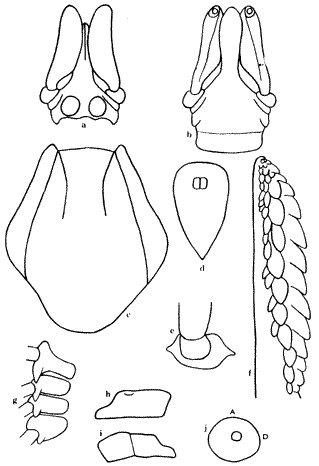 |
| I. holocyclus: female; a, capitulum (dorsal view); b, capitulum (ventral view); c, palpal article I (lateral view); d, hypostome; e, scutum; f, anal grooves; g, spiracular plate; h, tarsus I; i, tarsus IV. | Fig. 36.-I. cornuatus, female: a, capitulum (dorsal view); b, capitulurn (ventral view); c, scutum; d, anal grooves; e, palpal article 1 (lateral view); f, hypostome; g coxae; h, tarsus I; i, tarsus IV; j, spiracular plate. |
Ixodes holocylus Male |
Ixodes cornuatus Male |
 |
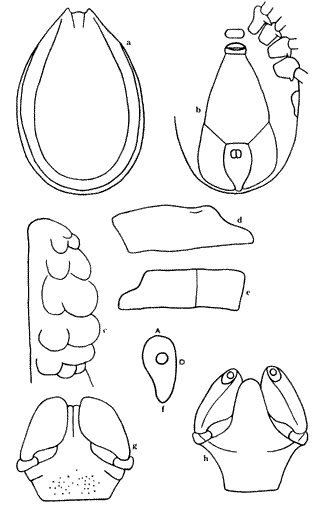 |
| I. holocyclus male- a, body (dorsal view); b, body (ventral view); c, capitulum (dorsal view); d, capitulum (ventral view); e, hypostome; f, tarsus I; g, tarsus IV; h, spiracular plate | I. cornuatus, male: a, body (dorsal view); b, body (ventral view); c, hypostome; d, tarsus I; e, tarsus IV; f, spiracular plate; g, capitulum (ventral view). |
Flurescence of Ixodes holocyclus
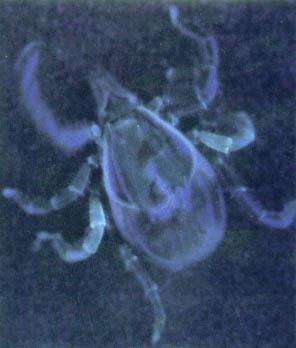
The
paralysis tick will, under ultraviolet lighting, show a greenish
hue to the dorsal shield distal to the capitulum as well as
distinct green colouring of the whole 3rd leg and the very tip of
the 4th leg. These "green" areas enable you to easily
detect a mobile tick (i.e. see leg movements) in a darkened space
(like reflective moving pedals on a bicycle at night.) This
observation may help identify a tick in the hair coat of a dog. (e.g.
to avoid complete clipping). However, it is not implied that this
in any way replaces finger searching in cases of tick paralysis.
It is not yet known if engorging embedded ticks will be the same
or the legs as clearly seen, or if different seasons/geography/years
produce individuals with varying levels of colour under UV light.
Such biological variation could be expected.
The figure shows UV fluorescence of the 3rd leg (from the head) and particularly the tips of the 4th leg. A line of fluorescence is also visible on the back of the tick down each side behind the head. The two lines meet at an area of irregularity associated with a mounting pin, but usually appear as a complete circle behind the head. Dead (and dehydrated) ticks do not fluoresce. Source: Atwell, R: Unusual Identification of Ixodes holocyclus; Aust Vet Practit 28(3), Sep 1998. Photgraphy, Prentice (modified to enhance effect).
The Paralysis Tick of Australia - Home
E-mail Us to report a broken link!
